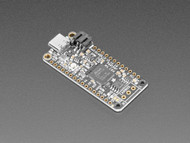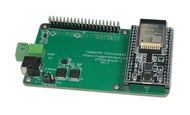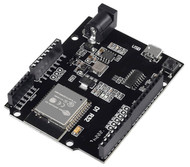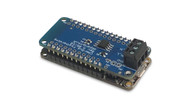Product Description
Free Shipping Within the United States!
The Adafruit HUZZAH32 Feather Board is a compact, feature-rich development platform designed for Internet of Things (IoT) projects and embedded systems. It is built around Espressif’s powerful ESP32-WROOM32 module, featuring integrated WiFi and Bluetooth connectivity, dual-core performance, and a broad range of I/O capabilities — all wrapped in Adafruit’s popular Feather form factor for compatibility with numerous add-on modules known as FeatherWings.
The board is ideal for advanced makers, engineers, and developers who need robust wireless communication, low-power operation, and flexible programming environments.
Key Features
-
Processor: Dual-core Tensilica LX6 CPU, clocked up to 240 MHz, capable of around 600 DMIPS of processing power.
-
Memory: 520 KB on-chip SRAM and 4 MB SPI flash memory.
-
Wireless Connectivity: Integrated 2.4 GHz WiFi (802.11 b/g/n) and Bluetooth (both Classic and BLE).
-
Power System:
-
Built-in LiPo/Li-ion battery charger.
-
USB-C or Micro-USB input for 5 V power.
-
Onboard 3.3 V voltage regulator with low dropout for efficient battery operation.
-
JST connector for battery use; automatic charging when connected to USB.
-
-
Feather Compatibility: Standard Feather layout for stacking with Adafruit FeatherWings such as OLED displays, relays, and sensor boards.
-
I/O Capabilities:
-
Approximately 12 ADC channels and 2 DAC outputs.
-
Multiple UART, SPI, and I²C interfaces.
-
Up to 10 capacitive touch inputs.
-
PWM output on most pins.
-
-
Sensors: Built-in Hall effect sensor and low-noise amplifier for analog applications.
-
Form Factor: Approximately 51 mm × 23 mm × 12 mm, small enough for portable and embedded applications.
-
Operating Voltage: 3.3 V logic level.
-
USB Interface: USB-to-Serial converter with automatic bootloader reset.
Power Management
The HUZZAH32 features an integrated battery charging system for portable applications. When powered via USB, it automatically charges an attached LiPo or Li-ion battery. The 3.3 V regulator ensures stable voltage for both the ESP32 chip and connected peripherals.
A “BAT” pin allows access to battery voltage for low-power sensors or external circuits. Developers should monitor current draw carefully in deep sleep modes since the overall current depends on additional onboard components such as voltage regulators and charging circuitry.
Deep sleep current is typically in the tens of microamps, but actual consumption varies depending on configuration and connected peripherals.
Pinout and Interfaces
The board follows Adafruit’s Feather layout, making it compatible with a wide ecosystem of stackable add-on boards. However, not all hardware functions of the ESP32 are pre-configured for Arduino IDE use. Developers may need to define additional UART, SPI, or I²C peripherals in firmware if advanced functionality is required.
Certain pins are boot-sensitive, meaning they must remain in specific states during startup. For example, GPIO0 is used for flashing mode, and some pins are restricted during boot. Reference documentation or pinout diagrams are recommended when designing custom shields.
Wireless and Networking
The ESP32-WROOM32 module integrates both WiFi and Bluetooth radios.
-
WiFi: Operates on 2.4 GHz bands using 802.11 b/g/n protocols. The onboard PCB trace antenna offers good signal range for most IoT projects, though metallic enclosures or poor antenna placement can reduce performance.
-
Bluetooth: Supports both Classic Bluetooth and BLE, allowing connection to smartphones, peripherals, and other BLE devices.
For best performance, mount the board in an area with clear line of sight for the PCB antenna. Avoid stacking metal-backed FeatherWings directly above the antenna region.
Software Support
The HUZZAH32 supports multiple development environments:
-
Arduino IDE: Simplified environment for general development. ESP32 board support can be installed via the Boards Manager.
-
ESP-IDF (Espressif IoT Development Framework): The official SDK for advanced applications, real-time tasks, and performance optimization.
-
CircuitPython: Supported as part of Adafruit’s open Python-on-microcontrollers platform, enabling rapid development without compilation.
Firmware examples are available for WiFi scanning, web server creation, Bluetooth beacons, and deep-sleep operation.
Recommended Applications
-
IoT Sensor Nodes: Ideal for environmental monitoring, smart agriculture, or industrial sensors that report data via WiFi or Bluetooth.
-
Wireless Control Systems: Used for home automation, robotics, and smart lighting.
-
Portable and Wearable Devices: Built-in battery charger and low-power modes support mobile use.
-
Feather Ecosystem Projects: Compatible with Adafruit FeatherWings for rapid prototyping with displays, GPS modules, data loggers, and motor drivers.
-
Edge Computing and AI Prototypes: Dual-core architecture supports multitasking and data pre-processing before cloud upload.
Performance Notes and Limitations
-
The board’s 4 MB flash memory is sufficient for most applications but may be limited for large file systems or complex OTA (over-the-air) updates.
-
While the ESP32 supports deep-sleep, actual current draw is higher than the bare module due to the onboard regulator and USB interface.
-
The PCB antenna limits long-range communication compared to boards with external antenna connectors.
-
3.3 V logic only — connecting 5 V logic signals can damage the microcontroller.
-
Complex projects may require using the ESP-IDF rather than relying solely on Arduino libraries for full feature access (e.g., dual-core threading, FreeRTOS tasks, I2S audio).
Setup and Usage Tips
-
First Steps:
-
Install the ESP32 board package in Arduino IDE.
-
Select “Adafruit HUZZAH32” from the Tools → Board menu.
-
Load the “Blink” example to verify operation.
-
-
Power Considerations:
-
When using a LiPo battery, ensure polarity matches the JST connector.
-
Avoid drawing excessive current through USB; external power may be required for high-power peripherals.
-
-
Wireless Setup:
-
WiFi operates only on 2.4 GHz networks (not 5 GHz).
-
Bluetooth should not be enabled simultaneously with heavy WiFi traffic if latency is critical.
-
-
Power Optimization:
-
Disable onboard LEDs and unused peripherals.
-
Enter deep sleep between sensor readings.
-
Minimize wake intervals to extend battery life.
-
-
Prototyping:
-
Use male headers to insert into a breadboard for testing.
-
Be cautious with boot pins (e.g., GPIO0, GPIO2, GPIO15).
-
Keep antenna area clear of metal or grounded parts.
-
Summary
The Adafruit HUZZAH32 Feather Board is a compact yet highly capable IoT development platform combining WiFi, Bluetooth, and battery-friendly design in one small package. It balances performance and versatility with ease of integration, making it well-suited for intermediate to advanced developers building wireless systems, portable devices, or smart environmental sensors.
Its dual-core processing, Feather compatibility, and robust community support make it a long-standing choice for makers and engineers needing reliable connectivity and flexible expansion options.
Documentation, Pinouts, Schematics, Arduino Setup, and more...
 Internet of Things Projects with ESP32: Build exciting and powerful IoT projects
Internet of Things Projects with ESP32: Build exciting and powerful IoT projects
The ESP32, a low-cost MCU with integrated Wi-Fi and BLE capabilities, comes with a variety of modules and development boards for building IoT applications efficiently. Wi-Fi and BLE are standard network stacks for Internet-of-Things applications providing cost-effective solutions for your business and project requirements.
This book is a fundamental guide for developing ESP32 programs and starts by explaining GPIO (General Purpose I/O) programming with sensor devices. The reader gets up to speed with ESP32 development through several IoT projects such as weather stations, sensor loggers, smart homes, Wi-Fi cams, and Wi-Fi wardriving. The reader learns how to use ESP32 boards to facilitate interactions between mobile applications and cloud servers, such as AWS.
By the end of this book, you'll have learned how to control a range of IoT projects using the ESP32 chip.
 Loading... Please wait...
Loading... Please wait...








